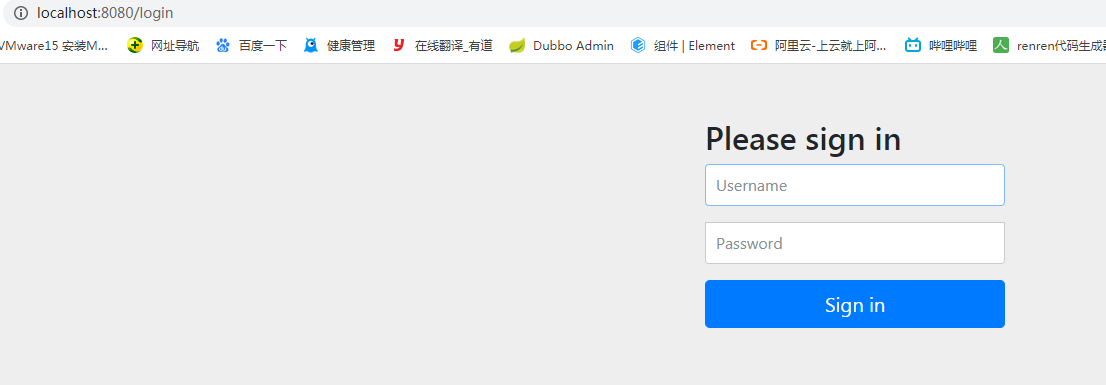一、安全简介
在 Web 开发中,安全一直是非常重要的一个方面,因此从应用开发的第一天就应该把安全相关的因素考虑进来,并在整个应用的开发过程中。
主要安全框架:Shiro,Spring Security
Spring Security 是一个功能强大且高度可定制的身份验证和访问控制框架。它实际上是保护基于 spring 的应用程序的标准。
Spring Security 是一个框架,侧重于为 Java 应用程序提供身份验证和授权。与所有 Spring 项目一样,Spring 安全性的真正强大之处在于它可以轻松地扩展以满足定制需求。
这是一个权限框架,权限 一般会细分为功能权限,访问权限,和菜单权限,代码会写的非常的繁琐,冗余。
Spring 是一个非常流行和成功的 Java 应用开发框架。Spring Security 基于 Spring 框架,提供了一套 Web 应用安全性的完整解决方案。一般来说,Web 应用的安全性包括用户认证(Authentication)和用户授权(Authorization)两个部分。用户认证指的是验证某个用户是否为系统中的合法主体,也就是说用户能否访问该系统。用户认证一般要求用户提供用户名和密码。系统通过校验用户名和密码来完成认证过程。用户授权指的是验证某个用户是否有权限执行某个操作。在一个系统中,不同用户所具有的权限是不同的。比如对一个文件来说,有的用户只能进行读取,而有的用户可以进行修改。一般来说,系统会为不同的用户分配不同的角色,而每个角色则对应一系列的权限。
对于上面提到的两种应用情景,Spring Security 框架都有很好的支持。在用户认证方面,Spring Security 框架支持主流的认证方式,包括 HTTP 基本认证、HTTP 表单验证、HTTP 摘要认证、OpenID 和 LDAP 等。在用户授权方面,Spring Security 提供了基于角色的访问控制和访问控制列表(Access Control List,ACL),可以对应用中的领域对象进行细粒度的控制。
二、认识 SpringSecurity
Spring Security 是针对 Spring 项目的安全框架,也是 Spring Boot 底层安全模块默认的技术选型,他可以实现强大的 Web 安全控制,对于安全控制,我们仅需要引入 spring-boot-starter-security 模块,进行少量的配置,即可实现强大的安全管理!
记住几个类:
WebSecurityConfigurerAdapter:自定义 Security 策略
AuthenticationManagerBuilder:自定义认证策略
@EnableWebSecurity:开启 WebSecurity 模式
Spring Security 的两个主要目标是 “认证” 和 “授权”(访问控制)。
“认证”(Authentication)
身份验证是关于验证您的凭据,如用户名/用户 ID 和密码,以验证您的身份。
身份验证通常通过用户名和密码完成,有时与身份验证因素结合使用。
“授权” (Authorization)
授权发生在系统成功验证您的身份后,最终会授予您访问资源(如信息,文件,数据库,资金,位置,几乎任何内容)的完全权限。
这个概念是通用的,而不是只在 Spring Security 中存在。
三、认证和授权
1.引入 Spring Security 模块
<dependency> <groupId>org.springframework.boot</groupId> <artifactId>spring-boot-starter-security</artifactId> </dependency>
复制代码
2.编写 Spring Security 配置类
基础配制
参考帮助文档:
https://docs.spring.io/spring-security/site/docs/5.3.0.RELEASE/reference/pdf/spring-security-reference.pdf
package com.dyt.config;import org.springframework.security.config.annotation.authentication.builders.AuthenticationManagerBuilder;import org.springframework.security.config.annotation.web.builders.HttpSecurity;import org.springframework.security.config.annotation.web.configuration.EnableWebSecurity;import org.springframework.security.config.annotation.web.configuration.WebSecurityConfigurerAdapter;@EnableWebSecurity // 开启WebSecurity模式public class SecurityConfig extends WebSecurityConfigurerAdapter { @Override protected void configure(HttpSecurity http) throws Exception { }}
复制代码
3.定制请求的授权规则
//授权// 链式编程@Overrideprotected void configure(HttpSecurity http) throws Exception { //首页所有人可以访问,功能页只有对应有权限的人才能访问 //请求授权的规则 http.authorizeRequests() .antMatchers("/").permitAll() .antMatchers("/level1/**").hasRole("vip1") .antMatchers("/level2/**").hasRole("vip2") .antMatchers("/level3/**").hasRole("vip3"); //没有权限默认会到登录页面,需要开启登录页面 // /login 请求来到登录页 // /login?error 重定向到这里表示登录失败 http.formLogin();}
复制代码
4.测试一下:发现,没有权限的时候,会跳转到登录的页面!
5.认证规则
重写 configure(AuthenticationManagerBuilder auth)方法
//认证//在内存中定义,也可以在jdbc中去拿....//Spring security 5.0中新增了多种加密方式,也改变了密码的格式。//要想我们的项目还能够正常登陆,需要修改一下configure中的代码。我们要将前端传过来的密码进行某种方式加密//spring security 官方推荐的是使用bcrypt加密方式。 @Override protected void configure(AuthenticationManagerBuilder auth) throws Exception { auth.inMemoryAuthentication().passwordEncoder(new BCryptPasswordEncoder()) .withUser("gdh").password(new BCryptPasswordEncoder().encode("123")).roles("vip2","vip3") .and() .withUser("root").password(new BCryptPasswordEncoder().encode("456")).roles("vip1","vip2","vip3") .and() .withUser("user").password(new BCryptPasswordEncoder().encode("123")).roles("vip1"); }
复制代码
测试,发现,登录成功,并且每个角色只能访问自己认证下的规则!搞定
四.权限控制和注销
1、开启自动配置的注销的功能
//定制请求的授权规则@Overrideprotected void configure(HttpSecurity http) throws Exception { //.... //开启自动配置的注销的功能 // /logout 注销请求 http.logout();}
复制代码
2、我们在前端,增加一个注销的按钮,index.html 导航栏中
<a class="item" th:href="@{/logout}"> <i class="address card icon"></i> 注销</a>
复制代码
3、我们可以去测试一下,登录成功后点击注销,发现注销完毕会跳转到登录页面!
4、但是,我们想让他注销成功后,依旧可以跳转到首页,该怎么处理呢?
// .logoutSuccessUrl("/"); 注销成功来到首页http.logout().logoutSuccessUrl("/");
复制代码
5、测试,注销完毕后,发现跳转到首页 OK
6、我们现在又来一个需求
用户没有登录的时候,导航栏上只显示登录按钮,用户登录之后,导航栏可以显示登录的用户信息及注销按钮!还有就是,比如 kuangshen 这个用户,它只有 vip2,vip3 功能,那么登录则只显示这两个功能,而 vip1 的功能菜单不显示!这个就是真实的网站情况了!该如何做呢?
我们需要结合 thymeleaf 中的一些功能
sec:authorize=”isAuthenticated()”:是否认证登录!来显示不同的页面
Maven 依赖:
<!-- https://mvnrepository.com/artifact/org.thymeleaf.extras/thymeleaf-extras-springsecurity4 --><dependency> <groupId>org.thymeleaf.extras</groupId> <artifactId>thymeleaf-extras-springsecurity5</artifactId> <version>3.0.4.RELEASE</version></dependency>
复制代码
7、修改我们的 前端页面
导入命名空间
xmlns:sec="http://www.thymeleaf.org/thymeleaf-extras-springsecurity5"
复制代码
修改导航栏,增加认证判断
<!--登录注销--> <div class="right menu"> <!--如果未登录--> <div sec:authorize="!isAuthenticated()"> <a class="item" th:href="@{/login}"> <i class="address card icon"></i> 登录 </a> </div> <!--如果已登录--> <div sec:authorize="isAuthenticated()"> <a class="item"> <i class="address card icon"></i> 用户名:<span sec:authentication="principal.username"></span> 角色:<span sec:authentication="principal.authorities"></span> </a> </div> <div sec:authorize="isAuthenticated()"> <a class="item" th:href="@{/logout}"> <i class="address card icon"></i> 注销 </a> </div></div>
复制代码
8、重启测试,我们可以登录试试看,登录成功后确实,显示了我们想要的页面;
9、如果注销 404 了,就是因为它默认防止 csrf 跨站请求伪造,因为会产生安全问题,我们可以将请求改为 post 表单提交,或者在 spring security 中关闭 csrf 功能;我们试试:在 配置中增加 http.csrf().disable();
http.csrf().disable();//关闭csrf功能:跨站请求伪造,默认只能通过post方式提交logout请求http.logout().logoutSuccessUrl("/");
复制代码
10、我们继续将下面的角色功能块认证完成!
<!-- sec:authorize="hasRole('vip1')" --><div class="column" sec:authorize="hasRole('vip1')"> <div class="ui raised segment"> <div class="ui"> <div class="content"> <h5 class="content">Level 1</h5> <hr> <div><a th:href="@{/level1/1}"><i class="bullhorn icon"></i> Level-1-1</a></div> <div><a th:href="@{/level1/2}"><i class="bullhorn icon"></i> Level-1-2</a></div> <div><a th:href="@{/level1/3}"><i class="bullhorn icon"></i> Level-1-3</a></div> </div> </div> </div></div><div class="column" sec:authorize="hasRole('vip2')"> <div class="ui raised segment"> <div class="ui"> <div class="content"> <h5 class="content">Level 2</h5> <hr> <div><a th:href="@{/level2/1}"><i class="bullhorn icon"></i> Level-2-1</a></div> <div><a th:href="@{/level2/2}"><i class="bullhorn icon"></i> Level-2-2</a></div> <div><a th:href="@{/level2/3}"><i class="bullhorn icon"></i> Level-2-3</a></div> </div> </div> </div></div><div class="column" sec:authorize="hasRole('vip3')"> <div class="ui raised segment"> <div class="ui"> <div class="content"> <h5 class="content">Level 3</h5> <hr> <div><a th:href="@{/level3/1}"><i class="bullhorn icon"></i> Level-3-1</a></div> <div><a th:href="@{/level3/2}"><i class="bullhorn icon"></i> Level-3-2</a></div> <div><a th:href="@{/level3/3}"><i class="bullhorn icon"></i> Level-3-3</a></div> </div> </div> </div></div>
复制代码
11、测试一下!
12、权限控制和注销搞定!
五.记住我
现在的情况,我们只要登录之后,关闭浏览器,再登录,就会让我们重新登录,但是很多网站的情况,就是有一个记住密码的功能,这个该如何实现呢?很简单
1、开启记住我功能
//定制请求的授权规则@Overrideprotected void configure(HttpSecurity http) throws Exception {//。。。。。。。。。。。 //记住我 http.rememberMe();}
复制代码
2、我们再次启动项目测试一下,发现登录页多了一个记住我功能,我们登录之后关闭 浏览器,然后重新打开浏览器访问,发现用户依旧存在!
3、我们点击注销的时候,可以发现,spring security 帮我们自动删除了这个 cookie
4、结论:登录成功后,将 cookie 发送给浏览器保存,以后登录带上这个 cookie,只要通过检查就可以免登录了。如果点击注销,则会删除这个 cookie。
六.定制登录页
现在这个登录页面都是 spring security 默认的,怎么样可以使用我们自己写的 Login 界面呢?
1、在刚才的登录页配置后面指定 loginpage
http.formLogin().loginPage("/toLogin");
复制代码
2、然后前端也需要指向我们自己定义的 login 请求
<a class="item" th:href="@{/toLogin}"> <i class="address card icon"></i> 登录</a>
复制代码
3、我们登录,需要将这些信息发送到哪里,我们也需要配置,login.html 配置提交请求及方式,方式必须为 post:
在 loginPage()源码中的注释上有写明:
<form th:action="@{/login}" method="post"> <div class="field"> <label>Username</label> <div class="ui left icon input"> <input type="text" placeholder="Username" name="username"> <i class="user icon"></i> </div> </div> <div class="field"> <label>Password</label> <div class="ui left icon input"> <input type="password" name="password"> <i class="lock icon"></i> </div> </div> <input type="submit" class="ui blue submit button"/></form>
复制代码
4、这个请求提交上来,我们还需要验证处理,怎么做呢?我们可以查看 formLogin()方法的源码!我们配置接收登录的用户名和密码的参数!
http.formLogin() .usernameParameter("username") .passwordParameter("password") .loginPage("/toLogin") .loginProcessingUrl("/login"); // 登陆表单提交请求
复制代码
5、在登录页增加记住我的多选框
<input type="checkbox" name="remember"> 记住我
复制代码
6、后端验证处理!
//定制记住我的参数!http.rememberMe().rememberMeParameter("remember");
复制代码
7、测试,OK
完整配制代码
package com.dyt.config;import org.springframework.security.config.annotation.authentication.builders.AuthenticationManagerBuilder;import org.springframework.security.config.annotation.web.builders.HttpSecurity;import org.springframework.security.config.annotation.web.configuration.EnableWebSecurity;import org.springframework.security.config.annotation.web.configuration.WebSecurityConfigurerAdapter;import org.springframework.security.crypto.bcrypt.BCryptPasswordEncoder;//AOP 横切 拦截器@EnableWebSecurity // 开启WebSecurity模式public class SecurityConfig extends WebSecurityConfigurerAdapter { //授权 // 链式编程 @Override protected void configure(HttpSecurity http) throws Exception { //首页所有人可以访问,功能页只有对应有权限的人才能访问 //请求授权的规则 http.authorizeRequests() .antMatchers("/").permitAll() .antMatchers("/level1/**").hasRole("vip1") .antMatchers("/level2/**").hasRole("vip2") .antMatchers("/level3/**").hasRole("vip3"); //没有权限默认会到登录页面,需要开启登录页面 http.formLogin() .usernameParameter("username") .passwordParameter("password") .loginPage("/toLogin") .loginProcessingUrl("/login"); // 登陆表单提交请求 http.csrf().disable();//关闭csrf功能:跨站请求伪造,默认只能通过post方式提交logout请求 //记住我 http.rememberMe().rememberMeParameter("remember"); //开启自动配置的注销的功能 // /logout 注销请求 // .logoutSuccessUrl("/"); 注销成功来到首页 http.logout().logoutSuccessUrl("/"); } //认证 //在内存中定义,也可以在jdbc中去拿.... //Spring security 5.0中新增了多种加密方式,也改变了密码的格式。 //要想我们的项目还能够正常登陆,需要修改一下configure中的代码。我们要将前端传过来的密码进行某种方式加密 //spring security 官方推荐的是使用bcrypt加密方式。 @Override protected void configure(AuthenticationManagerBuilder auth) throws Exception { auth.inMemoryAuthentication().passwordEncoder(new BCryptPasswordEncoder()) .withUser("gdh").password(new BCryptPasswordEncoder().encode("123")).roles("vip2","vip3") .and() .withUser("root").password(new BCryptPasswordEncoder().encode("456")).roles("vip1","vip2","vip3") .and() .withUser("user").password(new BCryptPasswordEncoder().encode("123")).roles("vip1"); }}
复制代码
文章转载自:二价亚铁.
原文链接:https://www.cnblogs.com/xw-01/p/18288051
体验地址:http://www.jnpfsoft.com/?from=infoq









评论